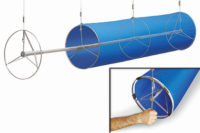
Even though Wilson specified fabric duct to fulfill the request for value engineering the project, government engineers who were previously unfamiliar with the technology accepted the specification, but contingent on smoke test results. "I think everybody (contractors, Marine engineers, consulting engineers, and architects attending the test) was really quite surprised at the smoke test result," said Philip Lucas, T.B.E., vice president of San Diego Air Balance, which performed the smoke test. "Not only did the air drop down to the government's required 6 ft level from the 50-ft ceiling, but the airflow was more evenly dispersed than metal duct and registers. The airflow in the duct seemed to be engineered perfectly," said Lucas, who has performed a couple of dozen smoke tests over his 25-year career.
"We're pleased with the system that was designed and put in place, and it has been working fine for almost a year without problem," added Bill Shatzer, project engineer, resident officer in charge of construction office, Camp Pendleton, U.S. Marine Corps.
Marine Blue Hits The Mark
Wilson, who had specified fabric duct in previous projects, used a straightforward design of a running one 32-in.-dia, 90-ft-long run parallel to the ceiling trusses for both the 11,000-sq-ft and the 12,400-sq-ft gyms. Manufactured by DuctSox™ Corp., the "Marine blue" TufTex fabric duct was factory engineered with 2.5-in.-dia high-throw orifices that run linear at the 4 o'clock and 8 o'clock positions. The orifice size was determined to yield adequate throw while the quantity of orifices was calculated to provide equal pressure and air dispersion along the entire length.Supplying the fabric duct is a sheet metal plenum fabricated by the project's mechanical contractor, A.O. Reed & Co., San Diego. The plenum has a series of volume dampers that distribute the 34,000-cfm and 30,000-cfm of air of each gym equally into each fabric duct run.
Wilson saved the Marines approximately 15% in labor and materials vs. specifying spiral metal duct and registers. Because it is 90% lighter than metal duct, fabric duct also saved the project in construction material costs because the tube joist/metal deck roof of the concrete block-style building didn't have as large of a weight load to support.
A/C and Improved IAQ at Minimal Cost
While the Marines' prescriptive approach to gymnasiums was a heat-vent system with unit heaters and large wall louvers for exhaust and outside air, Wilson and A.O Reed's approach offered the much-needed benefit of air conditioning while only raising the project cost 3% to 5%. "The exhaust louvers required for the proposed system were quite costly. The design-build team proposed the upgraded air conditioning system with fabric supply distribution ductwork. This creative alternative provided them with air conditioning and improved indoor air quality with only a slighter higher cost," said Wilson.The building's HVAC system is anchored by a 175-ton Trane chiller, and one 1,300-mbh Raypak boiler that supply five Trane Climate Changer air handlers. The building, which was designed by Sillman Wright Architects, San Diego, and construction managed by Harper Construction, San Diego, has an additional 41,000-sq-ft for free weights, aerobics, classrooms, and locker rooms. ES







